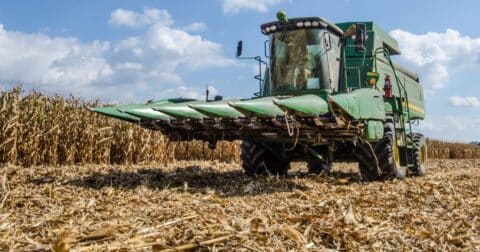Explainer
How Overconsumption Affects the Environment and Health, Explained
Climate•12 min read
Explainer
A closer look reveals a lack of transparency, and potentially negative effects.


Words by Seth Millstein
Over the last couple of years, the US Department of Agriculture has been funding various agricultural initiatives that it calls “climate-smart.” These are farming practices that, in the USDA’s estimation, provide some kind of benefit to the environment. But where is this climate-smart money actually going, and is it really doing anything to stop or slow climate change?
The impetus behind climate-smart farming policies is rather straightforward. Food production is currently responsible for almost one-third of all greenhouse gas emissions, with the majority of those emissions coming from animal agriculture. Over three-quarters of all freshwater and ocean eutrophication are the result of agricultural production, as is almost all habitat loss on the planet.
It’s clear that our farming practices need to change, and climate-smart policies are the U.S. government’s attempt to bring about this change. At least, that’s what the government says.
While the concept of agricultural practices that are good for the environment is nothing new, only recently did the U.S. government start using the phrase “climate-smart” to refer to such policies. Unfortunately, the term doesn’t have any official or legal definition, and as we’ll see, that’s resulted in a number of dubiously beneficial practices being dubbed “climate-smart.”
Broadly speaking, though, climate-smart policies are those that provide some sort of environmental benefit, or otherwise help slow climate change and global warming. Usually, this means that they either reduce carbon emissions or increase carbon capture by soil, trees and other sequesterers.
Climate-smart policies are funded by the USDA, which is in turn funded by Congress, and the USDA has many different programs through which it distributes climate-smart funds.
However, tracking the funding, progress and implementation of these climate-smart practices is quite difficult, in large part because the USDA has made it that way.
In 2022, the USDA announced the formation of Partnerships for Climate-Smart Commodities, a billion-dollar pilot program aimed at researching and testing the environmental benefits of various farming and forestry practices. Farmers and other agricultural producers could apply to receive grants from the USDA to spend on potentially climate-smart policies, and over the years, the USDA would measure how beneficial to the environment these practices actually were.
The USDA initially dedicated $1 billion to this program, and has added several billion more since then. But Jason Davidson, Senior Food and Agriculture Campaigner for the nonprofit Friends of the Earth, tells Sentient that the inner workings of this pilot program have been anything but transparent, with almost all of the process taking place behind closed doors.
“The USDA has been very opaque in describing not just the projects themselves, but even what sort of data they plan to collect [to evaluate them],” Davidson says. “All we can really say is that they have planned to give money to these organizations. On what schedule, or whether that’s a lump sum over the years, etc, is unclear.”
This lack of transparency makes it difficult to determine why, to take just one example, some of the largest meat companies on the planet, including Tyson, JBS and Perdue, received “climate-smart” funds through the Partnerships for Climate-Smart Commodities program.
“Tens of millions of dollars were given to projects where either a primary or secondary applicant was a major international meat company,” Davidson explains. “But the actual specifics of all of these programs are hard to decipher. The only sort of information that USDA released was who applied, how much money they were given and a brief description of the project.”
Take the “Climate-Smart Grasslands” grant. The goal of this initiative, according to the USDA, is to “market climate-smart beef with the ultimate goal of launching a cooperative to sell climate-smart beef products.” A partnership of 28 different entities, including JBS USA and Tyson, received $30 million to implement this project.
But what exactly is “climate-smart beef?” Sure, different methods of cattle farming vary in their environmental impacts, but none of those methods are beneficial to the climate. Beef production emits over twice the greenhouse gasses as any other protein on a per-gram basis, according to Our World In Data, and is the leading driver of deforestation worldwide.
Nevertheless, the USDA soon authorized Tyson to market their Brazen Beef subbrand as “climate-friendly,” and to claim on the packaging that it achieves a “10 percent greenhouse gas reduction.” Even if Brazen Beef’s production techniques really do produce 10 percent fewer greenhouse gasses than traditional beef production, though, they’re still emitting more than twice the greenhouse gasses than any other protein source.
But it’s not even clear that this 10 percent reduction is actually happening, as Tyson and the USDA have offered vanishingly few details as to how they’re achieving this supposed reduction. (Tyson is also being sued for these claims.) The USDA doesn’t directly monitor their implementation of these practices, and EWG says that when it asked the USDA for substantiation of this claim, the documents it received were heavily redacted in order to protect Tyson’s “trade secrets.”
This kind of opacity is indicative of the USDA’s general approach when pressed for details on its climate-smart policies, Davidson tells Sentient. Other environmental organizations, such as the Center for Biological Diversity, have also expressed frustration at the USDA’s lack of transparency regarding climate-smart policies, as have some members of Congress.
“Friends of the Earth and other organizations have submitted Freedom of Information Act requests to USDA over the last two years to try and get more information about these projects, and we have been largely unsuccessful, receiving heavily redacted documents in return,” Davidson says. “It is extremely unclear how the USDA evaluates these programs.”
When the 2022 Inflation Reduction Act was announced, information on it included $19.5 billion in funding for climate-smart policies. While it’s true that it contains $19.5 billion in funding for the USDA, the phrase “climate-smart” doesn’t actually appear anywhere in the law’s text.
In truth, the the IRA allocated this money to a selection of USDA conservation programs, and mandated that these programs use the money only on practices that “directly improve soil carbon, reduce nitrogen losses, or reduce, capture, avoid, or sequester carbon dioxide, methane, or nitrous oxide emissions, associated with agricultural production.”
Since then, the USDA has curated and maintained a list of programs that it considers to be “climate-smart,” which it updates annually. This list determines which specific practices are eligible to receive climate-smart funds provided by the IRA. In October 2023, the USDA added 14 new practices to its list of “climate-smart” policies.
A February investigation by the Environmental Working Group, however, found that one of the USDA’s newly designated “climate-smart” programs — waste storage facilities for animal farms — actually increases greenhouse emissions, according to the USDA’s own analysis from 2024. Note: though the 2024 data is no longer available on the USDA website, this author did review data provided by EWG.
Every five years, Congress has to renew the Farm Bill, an enormous package of legislation that undergirds American farming and agriculture. The last version of the bill has expired, and as usual, Republican and Democratic lawmakers are bickering over what the next bill should include. One of these arguments concerns the IRA’s funding for climate-smart policies.
In May, Republicans released a Farm Bill proposal that retained the $19.5 billion in funding that the IRA approved, but removed the requirement that this money go to initiatives that “directly improve soil carbon, reduce nitrogen losses, or reduce, capture, avoid, or sequester carbon dioxide, methane, or nitrous oxide emissions, associated with agricultural production.”
If this version of the Farm Bill passes, which looks increasingly probable given Republicans will control both the House and Senate, the $19.5 billion in “climate-smart” funding provided by the IRA would become $19.5 billion in general funding for the USDA’s conservation projects, regardless of their impact on the climate.
A 2022 analysis by EWG found that the overwhelming majority of funds from the USDA’s conservation programs don’t go to climate-smart projects, and the group estimates that if these “guardrails” from the IRA are removed, only one-fifth of the USDA’s conservation budget will go to programs that reduce greenhouse emissions.
It’s not a sure thing that this provision will be included in the final Farm Bill, which isn’t expected to pass until next year. Nevertheless, the fact that these guardrails are on the chopping block shows just how precarious funding for climate-smart projects is, regardless of their efficacy.
From a bird’s-eye perspective, it’s undoubtedly a good thing that the federal government has, at least in theory, recognized the importance of making America’s farming practices more sustainable.
But the extent to which these efforts have actually benefited the environment is entirely unclear. Some of the ostensibly “climate-smart” initiatives are anything but, and the USDA’s lack of transparency makes it difficult to measure the effectiveness of those that are.
Bringing about a more environmentally friendly farming system is a laudable goal, but the American government’s efforts to do so have been disappointing and lackluster at best.